Pycnanthe-Whom?
This year’s Perennial Plant of the Year award goes to an admittedly obscure selection, Pycnanthemum muticum. Attracting a wide range of beneficials is the pycnanthemum’s signature. Big bees, little bees (basically lots of bees), wasps, moths, caterpillars, and beetles all enjoy the nectar along with the shelter the habit provides. It outperforms superpollinators like salvia, and makes a natural anchor in the high summer for any pollinator program out there.
Among the pycnanthemums, muticum has the most ornamental value. Its silvery bracts surround the small flower as if it were a miniature poinsettia. Though the bracts are small, they tip the end of every stem so an entire drift of muticum feels like it’s frosted with a creamy white topping. Hardy to zone 4, it sits in a vertical column within a pot. When the plant matures, it reaches somewhere around 2 or 3 ft. tall. From far away, drifts look best; up close, it’s all about the stand and its bees.
If there’s any hesitation, it’s because pycnanthemum is a false mint. An optimist would say, “It spreads, but not as much as spearmint.” A pessimist would say, “It’s a kaigu. It’s not Godzilla, but it’s still a kaigu.” Personally, I think if you can handle monardas like Jacob Cline, you can handle pycnanthemums. They evolved in the same North American grasslands and meadows. In fact, entangling the two keeps them busy and slows both down a bit. Throw in an andropogon or solidago, and you have an easy-peasy corporate park.
Three of Pizzo's Selections: Muticum (blunt mountain mint) has the silvery bracts around the white flower, pilosum (hairy mountain mint) has larger, more scabiosa-style flowers, and tenuifolium (slender mountain mint) has the larger flowerheads over the slender leaves.
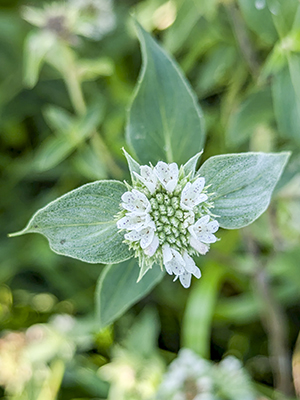 |
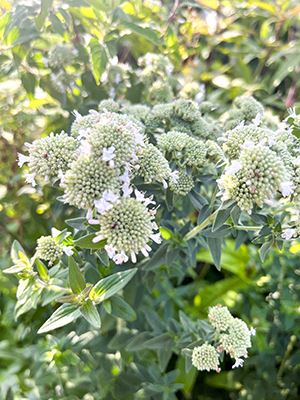 |
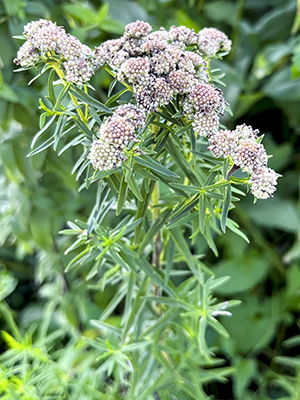 |
| muticum | pilosum | tenuifolium |
Sourcing the Material
Pycnanthemum already generates commercial revenue in the landscaping business. Corporate, hospitality, and housing markets see major benefits: attractive drifts, bunches of bees, a long lifespan, no disease, and natural rain and deer resistance. It crowds out the weeds, cuts down on mulch, and looks good from a long distance.
While muticum is available at a number of suppliers, pycnanthemum has interesting variations among its species. Two businesses actually have supplied a full pycnanthemum selection to the industry for decades.
Pizzo Native Plant Nursery in Illinois sells four species in 50 deep liners. They don’t have much trouble with spread in midwestern gardens. Dry soil and lower natural rain keep the plant in check. Pizzo has also profiled the distinctive minty scent of each type for customers who value fragrance:
- muticum: spearmint, sweet mint fragrance
- pilosum: strong and spicy peppermint, smells like a candy cane
- tenuifolium: very faint mint scent with a hint of grass
- virginianum: lemony, citronella mint scent
North Creek Nursery has a drift of muticum behind their greenhouses. A close-up shows how the bracts work with the flowerheads. They also sell flexuosum with an allium-style flowerhead.
 |
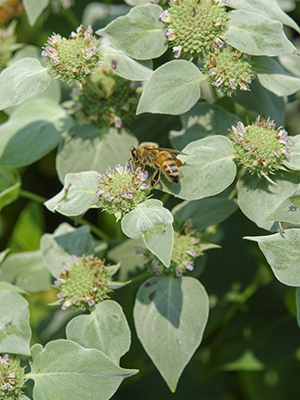 |
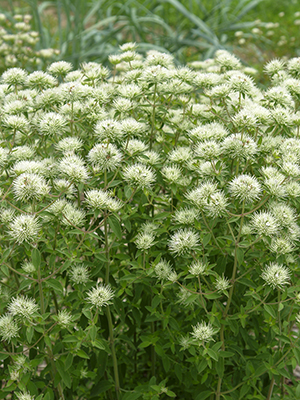 |
| A drift of muticum | muticum flowerhead with bracts | flexuosum |
North Creek Nurseries also sells in trays of 50 deep. They have one of the best photo libraries of pycnanthemums, a mix of flower mugshots and garden habit scenes that document the significant features of each species. Their website shows native mappings down to the county level and has a handy landscape calculator to figure out how many plants you need:
- flexuosum: better for shady gardens; slender leaves, no bracts, bigger flowers; core range in the Southeast leading up to the mountains (but not in them)
- muticum: tipped with silvery bracts; more compact habit; scattered widespread through the Eastern US
- pilosum: fuzzy foliage; a little taller; no bracts but a globe-ish flower; centered around Missouri and Illinois
- tenuifolium: dense foliage with slender thread-style leaves; no bracts, small flowers; pretty much everywhere in the East
When asking around, Prairie Moon Nursery comes up a lot. Their photo library is also excellent, especially the seed shots. They sell seed and liners directly to consumers, but they also provide a number of commercial growers with the seed they need to start their crops. Seed for pycnanthemum is considered easy to germinate: cast on top of the soil and expose to light.
From the breeding community comes Smokey Mountain Mint from Intrinsic Introductions. It’s a natural hybrid with the broad leaf and silver touches of muticum and the larger flowerheads of incanum. The quirk is its dark brown foliage, a little taller than muticum, with the silver frosting on top. Only the bees know where the bronze came from. Good photos on the site show the plant well.
Prairie Moon Nursery sells a wide range of Pycnanthemum seeds to the industry. The largest flowerheads probably belong to incanum, but the silvery bracts make muticum more visible at a distance. The seeds of Virginianum are typical of the genus: very small and easy to germinate.
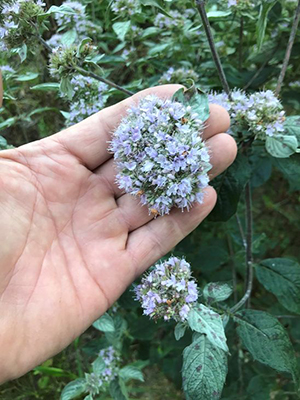 |
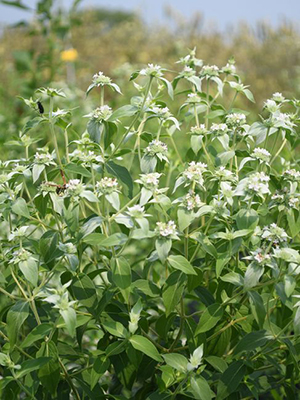 |
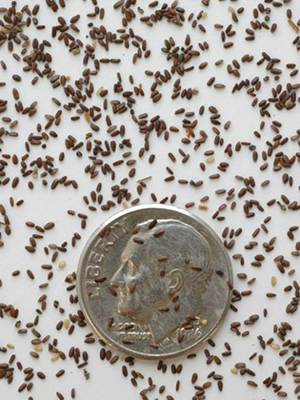 |
| incanum flowerhead | A stand of muticum | virginianum seeds |
The Shifting Psyche of Gardens
I should also point that that Mount Cuba inititalize a trial garden test for the genus earlier this year. They spent 2024 bring in material for a three-year run with a good number of choices in the ground by now. All this activity shows the bubbling interest in Pycnanathemums over the past few years.
The Perennial Plant of the Year for 2025 hints at an underlying shift in the psyche of the American garden. P. muticum is not the classic pretty plant with the big fat flower. Its signature feature is the diverse set of pollinators drawn to the plant.
An ornamental’s job is to color the home. Otherwise, our bedding gardens would be lined with alfalfa and soybeans. Here, muticum colors the home with butterflies, bees, and beneficials. For the mainstream American garden, the PPOY award shows a rising desire to integrate the garden into the local ecosystem. Ornamental is still important, but a new value has joined it. This is why muticum, the most ornamental of the pycnanthemums, caught the brass ring at the PPA.
Pycnanthemums are social media stars. This caterpillar disguises itself by gluing bits of the flower onto itself. 'Smokey Mountain Mint' is the bronze Pycnanthemum with the larger flowerhead and silvery bracts.
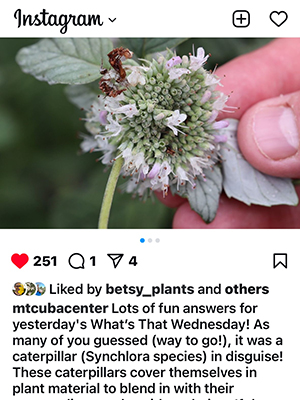 |
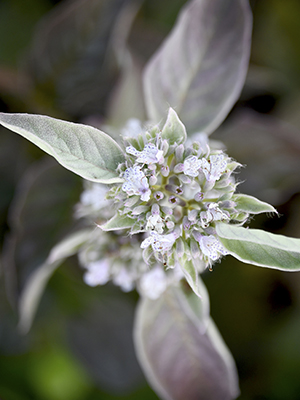 |
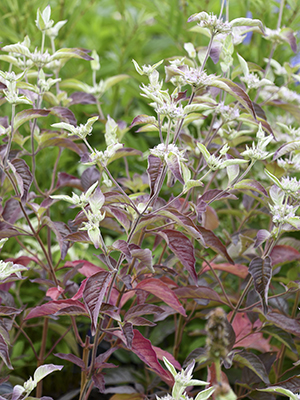 |
| Caterpillar social post | Smokey Mountain Mint | Silver top and dark foliage |
Popular Articles








